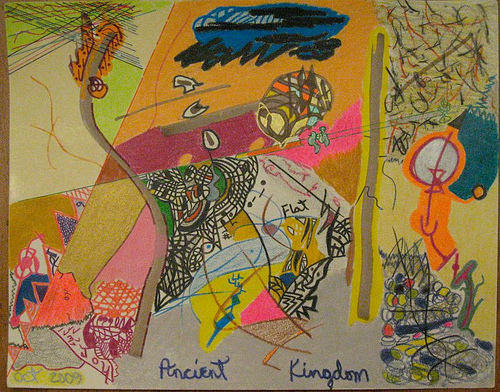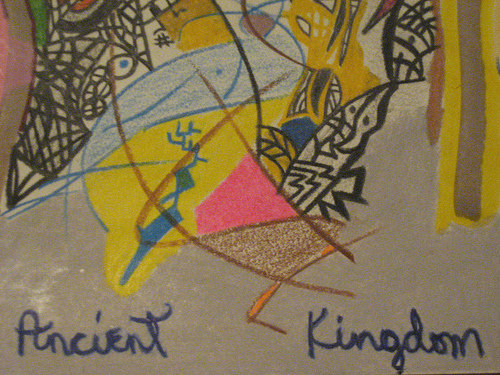The Visual as a Quickening Sound Vibration: An Interview with Musician Oluyemi Thomas, Part I

Oluyemi Thomas performing one of his compositions at the Joyce Gordon Gallery in Oakland. 9/12/10. Note the full-color music scores positioned at his feet. (Photo: Duane Deterville)
My interest in doing this interview with Oakland musician Oluyemi Thomas stems from a desire to get a wide range of answers to some questions that have held my interest for a number of years now. For example, how does the jazz aesthetic show up in the visual field? And, what are the visual markers indicating that we are “seeing” jazz? My goal is to explore the intersection between jazz music, spirituality, and ritual and to explain how these things are made present in the visual field. There are so many unexplored implications in the notion that jazz is more than a musical aesthetic and definitely more than entertainment. Oluyemi Thomas’s answers to my questions did not disappoint when addressing some of those unexplored implications. Now, well into the 21st century, we can demonstrate with profound examples that the jazz artist is more than a musician. In retrospect, when we consider the significance of someone like Louis Armstrong, we can see that oftentimes the profound, multidisciplinary genius of the jazz musician has been overshadowed by a status quo that reduced those contributions in the notion of modernism to entertainment. Musician-composer Anthony Braxton has publicly expressed his disappointment in the way that the intellectual output of black composers has been suppressed. (See “Forces in Motion: The Music and Thoughts of Anthony Braxton” by Graham Lock.) So, when I interviewed musician-composer Oluyemi Thomas, I was cognizant of the need to give full attention to the high station of achievement evidenced in his illuminated compositional scores.
When I met Mr. Thomas I was firmly convinced that what even those of us who revere them call a “jazz artist” is more than a musician. As our conversations continued it was reaffirmed for me that what they do is more than musical performance. It is a journey of self-transformation that is imbricated in the creation of the music. Thomas espouses a philosophy that expresses the music as more of a sacred social tool than just a device for commerce. Originally from the musically rich Motor City, Detroit, Michigan, he and his wife, the poet Ijeoma Thomas, have been Bay Area residents since 1974. He studied both music and mechanical engineering at Washtenaw College. It is very important that we note his career as an engineer because it is that professional training that is key to his development of the form, syntax, and visual language for his illuminated musical scores. Oluyemi Thomas creates ordered compositional free music that he acknowledges as part of — but not limited to — what is called jazz. Over a career spanning decades he has performed with Cecil Taylor, Joe McPhee, Henry Grimes, and William Parker amongst others, along with making several compelling recordings. His albums issued under the group name Positive Knowledge include At the Center of the Threshold and Invocation #9, in addition to a trio recording with Sirone and Michael Wimberly titled Beneath Tone’s Floor.
Thomas has been a fixture in the music scene in the East Bay for decades. I’ve seen him perform before, but it wasn’t until I heard him in performance about three years ago at a café in Oakland called Coffee with a Beat that I saw his full-color visual music scores. He was performing a piece in tandem with his wife reciting poetry when I noticed that he had pulled what looked to me like a full-color drawing vaguely reminiscent of Kandinsky from his music case. He laid it on the floor just a few feet from where I was sitting and began to play rich Eric Dolphy–like bass clarinet sounds. Deep, resonant, and sometimes speech-like music came from his horn. At one point he reached down and changed the orientation of the small complex drawing that he was reading with great intent and then resumed playing. In that instance I felt the character of his playing change, and at that very same moment I resolved that I had to talk to him about his intriguing brightly colored compositional scores. When he graciously agreed to be interviewed we talked for hours. He would seamlessly blend spiritual, aural, and visual descriptions of his compositions, sometimes punctuating our conversations with sounds from his bass clarinet or asking me to “see?” Our discussions took place in 2011 at his home in Oakland. This is the first installment of a three-part interview.
Oluyemi Thomas: You know, usually I don’t talk to people about my scores.
Duane Deterville: Is that right?
Thomas: Well, you know, usually people don’t ask. They just don’t ask. They act like, that was a mistake. People look at it and say, “I didn’t see that.” Because they’ll look at it, and it goes past what they know. They say, “Well, you just had some pictures up there.” See, that’s why I was straightening you out when I said “compositions.”
Deterville: I was calling them “drawings,” and you were saying “compositions.”
Thomas: They are compositions.
Deterville: How do you label your style of music? Or, do you label it at all?
Thomas: Well, adventurous composition. Yeah, I’m an adventurous artist.
Deterville: I know that musicians as significant as Max Roach, Duke Ellington, and Yusef Lateef have said, “Don’t call the music jazz.” Lateef in particular renamed his music “autophysiopsychic” music. So, would you call what you play jazz?
Thomas: It’s adventurous jazz. I mean, that could be one term, but I like adventurous music. I’ve learned from the jazz musician — who they have called jazz musicians, whether they call themselves jazz musicians or not. They work with a certain formula that we call jazz. I’ve learned from them. Yeah, they’re my teachers.
Deterville: Would you say that’s part of the repertoire that you have, one of the formulas that you use, and then there is a whole other world of formulas?
Thomas: Exactly, exactly. Wadada Leo Smith, the trumpeter, he uses the expression, “It’s within the tradition of this music.” I’ve worked with him and we’ve talked a lot, so I can agree with that.
Deterville: You mentioned that you’ve been making visual work even before the compositions 30 years ago. Did music inspire the early visual work?
Thomas: Well, see, I’m an engineer, too. I was in the design department, so we’d lay these designs out for power plants. With all these symbols we had ledgers for all of these things. Valves, piping and structural things. We have ledgers so that everybody’s on the same page. So I said, “What if I make these be what I want them to be?” The question became, “If I shift this and make this be some other experience, what would that look like?” So I started to create some compositions, and I started studying them as such. I just used my templates, triangles and rectangles, circles, ellipticals, straight lines, scales, and some freehand. That was when I was with Bechtel Engineering. I worked with them in Michigan, then I transferred out to San Francisco back in 1974. I was always working the music. That enabled me to just lay some scores out and some colorings and so forth. I was using color, but it wasn’t much. It still had a definite affinity with engineering. I started these compositions in the ’70s. When I was doing engineering full time, that was like 1974, five, six. Before the 1980s. So what we’ve got here is over 30 years — almost 40 years — of discipline. My engineering life, my music life, my vegetarian life, and life in the Bahai Faith. I integrated all of that into it, because that’s who I am. So all of my concepts are to eliminate the divide, because it’s all one entity with different applications.
Deterville: So you created your own set of languages for those symbols, and your own musical legend for that.
Thomas: Yes, musical. Musical and nonmusical. Let’s say beyond musical. You know that Western concept of how one should compose, I began to see that that was limited.
Deterville: That’s the one thing about your narrative that really fascinated me, man. You went to Washtenaw College, studying music and engineering at the same time. And fused the two into a single discipline.
Thomas: That was 1970 when I started at Washtenaw College. September 1970. That’s in Ann Arbor, Michigan. Not too far from the University of Michigan.
Deterville: I’m fascinated by how you arrived at this point in your creativity. There’s this whole notion of synesthesia, which simply means being able to see music. I’m thinking to myself, as visually involved as your compositions are, when you’re playing or even when you’re hearing someone else play, do you see music? Are you able to form a visual concept of what you’re hearing? You’ve said that every color has a sound.
Thomas: Yes, it does, and it’s moving, too. It’s moving, and it’s vibrating. Now you’re dealing with the construction of the human being. It’s good to recognize that. We have an intense love with beauty and symmetry. But, yeah, that does happen. Because, see, the colors and the shapes form a composite. So you’ve got precomposites that announce that the composite is coming. The pre-moment announces that the moment is coming. So, inside the moment are compositions or particles of a composition. They’re compositional moments.
Deterville: Can you give me an example of how you translate the meaning of some of the symbols and how they translate into music?
Thomas: Well, you know, music is symbols describing life. See? So, you know we’ve got these different notes, G and F, E, and all of these. But they’re exact notes to depict a tale. See? But we get it mixed up sometimes, we just say this person is excellent because he can execute the score. But what does it tell you? See, that’s the difference between Western music, apart from opera, and the music of people of color. The tale is first for us, at least from my conversations and studies with people. We’re more interested in telling the tale and using the composition or arrangement as a means to tell the tale. We perfect that so that we can tell the tale.
End of part I.

